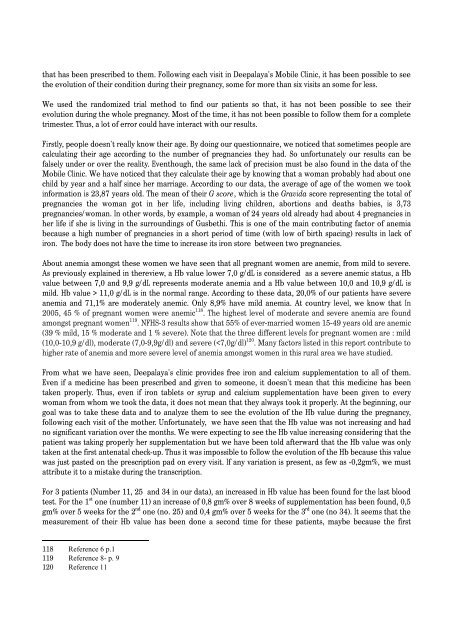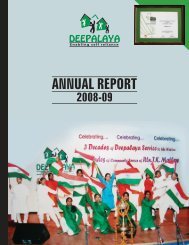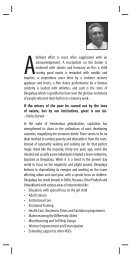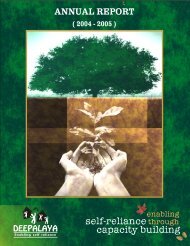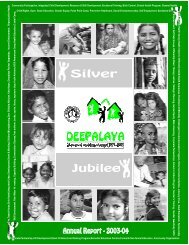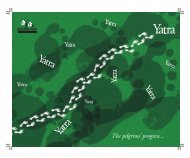Report 2011 - Deepalaya
Report 2011 - Deepalaya
Report 2011 - Deepalaya
You also want an ePaper? Increase the reach of your titles
YUMPU automatically turns print PDFs into web optimized ePapers that Google loves.
that has been prescribed to them. Following each visit in <strong>Deepalaya</strong>'s Mobile Clinic, it has been possible to see<br />
the evolution of their condition during their pregnancy, some for more than six visits an some for less.<br />
We used the randomized trial method to find our patients so that, it has not been possible to see their<br />
evolution during the whole pregnancy. Most of the time, it has not been possible to follow them for a complete<br />
trimester. Thus, a lot of error could have interact with our results.<br />
Firstly, people doesn't really know their age. By doing our questionnaire, we noticed that sometimes people are<br />
calculating their age according to the number of pregnancies they had. So unfortunately our results can be<br />
falsely under or over the reality. Eventhough, the same lack of precision must be also found in the data of the<br />
Mobile Clinic. We have noticed that they calculate their age by knowing that a woman probably had about one<br />
child by year and a half since her marriage. According to our data, the average of age of the women we took<br />
information is 23,87 years old. The mean of their G score, which is the Gravida score representing the total of<br />
pregnancies the woman got in her life, including living children, abortions and deaths babies, is 3,73<br />
pregnancies/woman. In other words, by example, a woman of 24 years old already had about 4 pregnancies in<br />
her life if she is living in the surroundings of Gusbethi. This is one of the main contributing factor of anemia<br />
because a high number of pregnancies in a short period of time (with low of birth spacing) results in lack of<br />
iron. The body does not have the time to increase its iron store between two pregnancies.<br />
About anemia amongst these women we have seen that all pregnant women are anemic, from mild to severe.<br />
As previously explained in thereview, a Hb value lower 7,0 g/dL is considered as a severe anemic status, a Hb<br />
value between 7,0 and 9,9 g/dL represents moderate anemia and a Hb value between 10,0 and 10,9 g/dL is<br />
mild. Hb value > 11,0 g/dL is in the normal range. According to these data, 20,0% of our patients have severe<br />
anemia and 71,1% are moderately anemic. Only 8,9% have mild anemia. At country level, we know that In<br />
2005, 45 % of pregnant women were anemic 118 . The highest level of moderate and severe anemia are found<br />
amongst pregnant women 119 . NFHS-3 results show that 55% of ever-married women 15-49 years old are anemic<br />
(39 % mild, 15 % moderate and 1 % severe). Note that the three different levels for pregnant women are : mild<br />
(10,0-10,9 g/dl), moderate (7,0-9,9g/dl) and severe (


